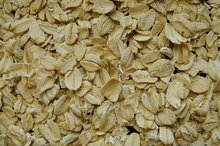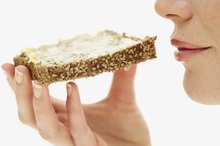What does fact checked mean?
At Healthfully, we strive to deliver objective content that is accurate and up-to-date. Our team periodically reviews articles in order to ensure content quality. The sources cited below consist of evidence from peer-reviewed journals, prominent medical organizations, academic associations, and government data.
- American Heart Association: Cholesterol, Fiber and Oat Brain
- American Heart Association: Whole Grains and Fiber
- Mayo Clinic: Cholesterol: Top 5 Foods to Lower Your Numbers
The information contained on this site is for informational purposes only, and should not be used as a substitute for the advice of a professional health care provider. Please check with the appropriate physician regarding health questions and concerns. Although we strive to deliver accurate and up-to-date information, no guarantee to that effect is made.
Shredded Wheat & Cholesterol
Imagine if you could stave off heart disease simply by eating the correct food. That may sound like a far-fetched fantasy, but for some people it's quite close to reality. The key lies in managing cholesterol, which can build up in your arteries and increase your risk for heart problems. While there's no such thing as a miracle cure, foods like shredded wheat may well help your body fight cholesterol, protecting your heart from disease.
Shredded Wheat and Fiber
The American Heart Association describes fiber as "several materials in the parts of plants that your body can't digest." When grain is milled, the bran and germ are removed 12. Whole-grain foods are not milled in the same way; they contain the bran and germ, which are good sources of fiber and other nutrients. The average adult should try to eat about 25 g of fiber every day; shredded wheat contains between 2.2 and 6 g of fiber per serving.
- The American Heart Association describes fiber as "several materials in the parts of plants that your body can't digest."
- Whole-grain foods are not milled in the same way; they contain the bran and germ, which are good sources of fiber and other nutrients.
Types of Fiber in Shredded Wheat
How Much Oatmeal Is Needed to Reduce Cholesterol?
Learn More
Fiber is generally divided into two types: soluble and insoluble. According to a review in the "American Journal of Clinical Nutrition," soluble fiber dissolves in water and undergoes specific chemical reactions in your body, while insoluble fiber simply absorbs water and passes through your body. A single serving of shredded wheat contains about 1 g of soluble and 5 g of insoluble fiber.
Shredded Wheat and Cholesterol
According to the American Heart Association, soluble fiber has been associated with lowered LDL, or "bad," cholesterol levels 12. If you eat lots of saturated and trans fats, cholesterol builds up in your arteries. Soluble fiber reduces the amount of cholesterol absorbed into your bloodstream. The Mayo Clinic states that 5 to 10 g of soluble fiber per day is enough to reduce your cholesterol 3. That's at least five servings of shredded wheat or other whole-grain foods every day.
Shredded Wheat and Heart Disease
Oat Bran Vs. Oatmeal for Cholesterol
Learn More
Cholesterol buildup tends to clog arteries, making it a leading factor in heart disease. By reducing cholesterol, the soluble fiber in shredded wheat can lower your risk of heart disease. Shredded wheat also contains insoluble fiber, which does not seem to have an effect on cholesterol. However, the American Heart Association claims that insoluble fiber is associated with lowered heart disease risk, perhaps because it can make you feel full so you don't overeat 12.
- Cholesterol buildup tends to clog arteries, making it a leading factor in heart disease.
- However, the American Heart Association claims that insoluble fiber is associated with lowered heart disease risk, perhaps because it can make you feel full so you don't overeat 1.
Expert Insight
Research on the effectiveness of wheat fiber is still ongoing. The "American Journal of Clinical Nutrition" reports that there may be differences in the fiber from various types of grain. Most scientific studies on fiber have focused on oat products, which are high in soluble fiber. Wheat is higher in insoluble fiber, and therefore has not been tested as fully as other types of grains. Shredded wheat is certainly good for your health, but oatmeal or oat-based breakfast foods may be more effective against cholesterol.
- Research on the effectiveness of wheat fiber is still ongoing.
- The "American Journal of Clinical Nutrition" reports that there may be differences in the fiber from various types of grain.
Related Articles
References
- American Heart Association: Cholesterol, Fiber and Oat Brain
- American Heart Association: Whole Grains and Fiber
- Mayo Clinic: Cholesterol: Top 5 Foods to Lower Your Numbers
- Ho HV, Sievenpiper JL, Zurbau A, et al. The effect of oat β-glucan on LDL-cholesterol, non-HDL-cholesterol and apoB for CVD risk reduction: a systematic review and meta-analysis of randomised-controlled trials. Br J Nutr. 2016;116(8):1369-1382. doi:10.1017/S000711451600341X
- Zhou Q, Wu J, Tang J, Wang JJ, Lu CH, Wang PX. Beneficial effect of higher dietary fiber intake on plasma HDL-C and TC/HDL-C ratio among Chinese rural-to-urban migrant workers. Int J Environ Res Public Health. 2015;12(5):4726–4738. doi:10.3390/ijerph120504726
- Ramos SC, Fonseca FA, Kasmas SH, et al. The role of soluble fiber intake in patients under highly effective lipid-lowering therapy. Nutr J. 2011;10:80. doi:10.1186/1475-2891-10-80
- Cleveland Clinic. Heart healthy eating to help lower cholesterol levels. Reviewed February 2018.
- Third Report of the National Cholesterol Education Program (NCEP) Expert Panel on Detection, Evaluation, and Treatment of High Blood Cholesterol in Adults (PDF). July 2004, The National Institutes of Health: The National Heart, Lung, and Blood Institute.
- Brown L, Rosner B, Willett WW, Sacks FM. Cholesterol-lowering effects of dietary fiber: a meta-analysis. Am J Clin Nutr. 1999;69(1):30-42. doi:10.1093/ajcn/69.1.30
- Poli A, Marangoni F, Paoletti R, et al. Non-pharmacological control of plasma cholesterol levels. Nutr Metab Cardiovasc Dis. 2008;18(2):S1-16. doi10.1016/j.numecd.2007.10.004
- Rolfes SR, Whitney E. Understanding Nutrition, 3rd ed 2005.
Resources
Writer Bio
An award-winning blogger, Jessica Blue has been promoting sustainability, natural health and a do-it-yourself attitude since graduating University of California, Berkeley in 2000. Her work, seen in a wide variety of publications, advocates an environmentally-responsible and healthy lifestyle.









